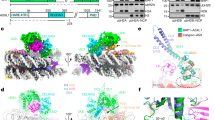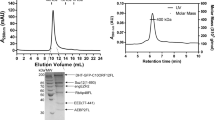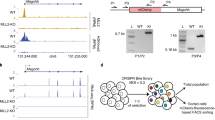Abstract
Covalent modification of histones is fundamental in orchestrating chromatin dynamics and transcription1,2,3. One example of such an epigenetic mark is the mono-ubiquitination of histones, which mainly occurs at histone H2A and H2B4,5,6. Ubiquitination of histone H2A has been implicated in polycomb-mediated transcriptional silencing7,8,9. However, the precise role of the ubiquitin mark during silencing is still elusive. Here we show in human cell lines that ZRF1 (zuotin-related factor 1) is specifically recruited to histone H2A when it is ubiquitinated at Lys 119 by means of a novel ubiquitin-interacting domain that is located in the evolutionarily conserved zuotin domain. At the onset of differentiation, ZRF1 specifically displaces polycomb-repressive complex 1 (PRC1) from chromatin and facilitates transcriptional activation. A genome-wide mapping of ZRF1, RING1B and H2A-ubiquitin targets revealed its involvement in the regulation of a large set of polycomb target genes, emphasizing the key role ZRF1 has in cell fate decisions. We provide here a model of the molecular mechanism of switching polycomb-repressed genes to an active state.
This is a preview of subscription content, access via your institution
Access options
Subscribe to this journal
Receive 51 print issues and online access
$199.00 per year
only $3.90 per issue
Buy this article
- Purchase on Springer Link
- Instant access to full article PDF
Prices may be subject to local taxes which are calculated during checkout




Similar content being viewed by others
References
Strahl, B. D. & Allis, C. D. The language of covalent histone modifications. Nature 403, 41–45 (2000)
Li, B., Carey, M. & Workman, J. L. The role of chromatin during transcription. Cell 128, 707–719 (2007)
Kouzarides, T. Chromatin modifications and their function. Cell 128, 693–705 (2007)
Goldknopf, I. L. et al. Isolation and characterization of protein A24, a “histone-like” non-histone chromosomal protein. J. Biol. Chem. 250, 7182–7187 (1975)
Zhu, B. et al. Monoubiquitination of human histone H2B: the factors involved and their roles in HOX gene regulation. Mol. Cell 20, 601–611 (2005)
Nickel, B. E., Allis, C. D. & Davie, J. R. Ubiquitinated histone H2B is preferentially located in transcriptionally active chromatin. Biochemistry 28, 958–963 (1989)
Wang, H. et al. Role of histone H2A ubiquitination in Polycomb silencing. Nature 431, 873–878 (2004)
Kuzmichev, A., Nishioka, K., Erdjument-Bromage, H., Tempst, P. & Reinberg, D. Histone methyltransferase activity associated with a human multiprotein complex containing the Enhancer of Zeste protein. Genes Dev. 16, 2893–2905 (2002)
Zhou, W. et al. Histone H2A monoubiquitination represses transcription by inhibiting RNA polymerase II transcriptional elongation. Mol. Cell 29, 69–80 (2008)
Pan, X. et al. A DNA integrity network in the yeast Saccharomyces cerevisiae. Cell 124, 1069–1081 (2006)
Greiner, J. et al. Characterization of several leukemia-associated antigens inducing humoral immune responses in acute and chronic myeloid leukemia. Int. J. Cancer 106, 224–231 (2003)
Resto, V. A. et al. A putative oncogenic role for MPP11 in head and neck squamous cell cancer. Cancer Res. 60, 5529–5535 (2000)
Inoue, T., Shoji, W. & Obinata, M. MIDA1, an Id-associating protein, has two distinct DNA binding activities that are converted by the association with Id1: a novel function of Id protein. Biochem. Biophys. Res. Commun. 266, 147–151 (1999)
Hicke, L., Schubert, H. L. & Hill, C. P. Ubiquitin-binding domains. Nature Rev. Mol. Cell Biol. 6, 610–621 (2005)
Bracken, A. P., Dietrich, N., Pasini, D., Hansen, K. H. & Helin, K. Genome-wide mapping of Polycomb target genes unravels their roles in cell fate transitions. Genes Dev. 20, 1123–1136 (2006)
Lee, M. G. et al. Demethylation of H3K27 regulates polycomb recruitment and H2A ubiquitination. Science 318, 447–450 (2007)
Saito, S. et al. Haptoglobin-β chain defined by monoclonal antibody RM2 as a novel serum marker for prostate cancer. Int. J. Cancer 123, 633–640 (2008)
Andrews, P. W. Retinoic acid induces neuronal differentiation of a cloned human embryonal carcinoma cell line in vitro. Dev. Biol. 103, 285–293 (1984)
Andrews, P. W. et al. Pluripotent embryonal carcinoma clones derived from the human teratocarcinoma cell line Tera-2. Differentiation in vivo and in vitro. Lab. Invest. 50, 147–162 (1984)
Boyer, L. A. et al. Polycomb complexes repress developmental regulators in murine embryonic stem cells. Nature 441, 349–353 (2006)
Kallin, E. M. et al. Genome-wide uH2A localization analysis highlights Bmi1-dependent deposition of the mark at repressed genes. PLoS Genet. 5, e1000506 (2009)
O’Geen, H. et al. Genome-wide analysis of KAP1 binding suggests autoregulation of KRAB-ZNFs. PLoS Genet. 3, e89 (2007)
Pasini, D., Bracken, A. P., Hansen, J. B., Capillo, M. & Helin, K. The polycomb group protein Suz12 is required for embryonic stem cell differentiation. Mol. Cell. Biol. 27, 3769–3779 (2007)
Villa, R. et al. Role of the polycomb repressive complex 2 in acute promyelocytic leukemia. Cancer Cell 11, 513–525 (2007)
Nakagawa, T. et al. Deubiquitylation of histone H2A activates transcriptional initiation via trans-histone cross-talk with H3K4 di- and trimethylation. Genes Dev. 22, 37–49 (2008)
Levinger, L. & Varshavsky, A. Selective arrangement of ubiquitinated and D1 protein-containing nucleosomes within the Drosophila genome. Cell 28, 375–385 (1982)
Lagarou, A. et al. dKDM2 couples histone H2A ubiquitylation to histone H3 demethylation during Polycomb group silencing. Genes Dev. 22, 2799–2810 (2008)
Doil, C. et al. RNF168 binds and amplifies ubiquitin conjugates on damaged chromosomes to allow accumulation of repair proteins. Cell 136, 435–446 (2009)
Otto, H. et al. The chaperones MPP11 and Hsp70L1 form the mammalian ribosome-associated complex. Proc. Natl Acad. Sci. USA 102, 10064–10069 (2005)
Brummelkamp, T. R., Nijman, S. M., Dirac, A. M. & Bernards, R. Loss of the cylindromatosis tumour suppressor inhibits apoptosis by activating NF-κB. Nature 424, 797–801 (2003)
Dignani, J. D., Lebovitz, R. M. & Roeder, R. G. Accurate transcription initiation by RNA polymerase II in a soluble extract from isolated mammalian nuclei. Nucleic Acids Res. 11, 1475–1489 (1983)
Gibbons, F. D., Proft, M., Struhl, K. & Roth, F. P. Chipper: discovering transcription-factor targets from chromatin immunoprecipitation microarrays using variance stabilization. Genome Biol. 6, R96 (2005)
Huang, D. W., Sherman, B. T. & Lempicki, R. A. Systematic and integrative analysis of large gene lists using DAVID bioinformatics resources. Nature Protocols 4, 44–57 (2009)
Acknowledgements
We are indebted to S. Jentsch, S. Berger, K. Helin, J. Hasskarl, R. Shiekattar, T. Zimmermann and V. Raker for antibodies and plasmids and for discussions; and to the CRG Microarray facility and Light Microscopy Facility. This work was supported by the Spanish “Ministerio de Educación y Ciencia” (BFU2007-63059), the Association for International Cancer Research (10-0177), by the AGAUR and Consolider to L.D.C., and by FOR967 to S.R.; H.R. was supported by a FEBS fellowship; J.R. by a fellowship from Fundação para a Ciência e Tecnologia; L.R.-V. by a Juan de la Cierva Fellowship; S.D. by a PFIS fellowship.
Author information
Authors and Affiliations
Contributions
H.R. cloned, purified proteins and performed biochemical studies. H.R., L.R.-V., J.D.R. and S.D. performed ChIP analysis. G.G. and N.L.-B. performed genome-wide analysis. T.N. and T.I. performed in vitro transcription and deubiquitination experiments. S.R. provided essential tools. H.R. and L.D.C. designed the experiments, supervised the project and wrote the manuscript. All authors commented on the manuscript.
Corresponding author
Ethics declarations
Competing interests
The authors declare no competing financial interests.
Supplementary information
Supplementary Information
This file contains a Supplementary Discussion, additional references and Supplementary Figures 1-12 with legends. (PDF 3601 kb)
Supplementary Table 1
This file contains a list of proteins identified by affinity-chromatography and subsequent MALDI spectrometry. (PDF 37 kb)
Supplementary Table 2
This file contains a list of ZRF1 Chip-chip targets and ZRF1/Suz12 Co-targets. (XLS 1498 kb)
Supplementary Table 3
This file contains a selection of ZRF1 target genes after induction with RA (1h), which are clustered with respect to their function in developmental pathways. (PDF 75 kb)
Supplementary Table 4
This file contains a list of Ring1b Chip-chip targets, Ring1b-ZRF1, Ring1b-Suz12 and Ring1b-H3K27me3 Co-targets. (XLS 3784 kb)
Supplementary Table 5
This file contains a list of H2Aub Chip-chip targets, H2Aub-ZRF1, H2Aub-Ring1b, H2Aub-Suz12 and H2Aub-H3K27me3 Co-targets. (XLS 2720 kb)
Supplementary Table 6
This file contains a list of genes downregulated in ZRF1 knockdown cells in comparison to control cells after stimulation with RA. (XLS 231 kb)
Rights and permissions
About this article
Cite this article
Richly, H., Rocha-Viegas, L., Ribeiro, J. et al. Transcriptional activation of polycomb-repressed genes by ZRF1. Nature 468, 1124–1128 (2010). https://doi.org/10.1038/nature09574
Received:
Accepted:
Published:
Issue Date:
DOI: https://doi.org/10.1038/nature09574
This article is cited by
-
UV-induced G4 DNA structures recruit ZRF1 which prevents UV-induced senescence
Nature Communications (2023)
-
Redefining germline predisposition in children with molecularly characterized ependymoma: a population-based 20-year cohort
Acta Neuropathologica Communications (2022)
-
RNF8 up-regulates AR/ARV7 action to contribute to advanced prostate cancer progression
Cell Death & Disease (2022)
-
p113 isoform encoded by CUX1 circular RNA drives tumor progression via facilitating ZRF1/BRD4 transactivation
Molecular Cancer (2021)
-
The molecular principles of gene regulation by Polycomb repressive complexes
Nature Reviews Molecular Cell Biology (2021)
Comments
By submitting a comment you agree to abide by our Terms and Community Guidelines. If you find something abusive or that does not comply with our terms or guidelines please flag it as inappropriate.



